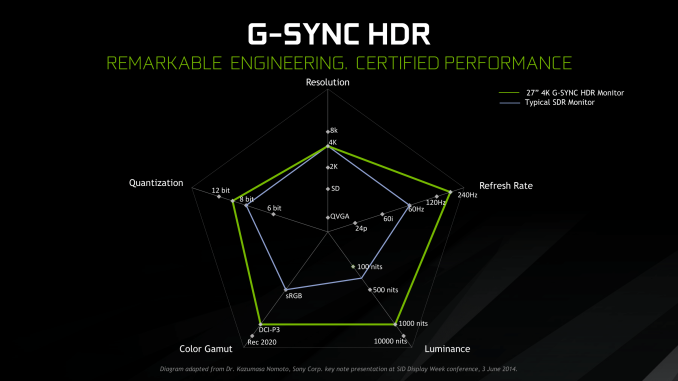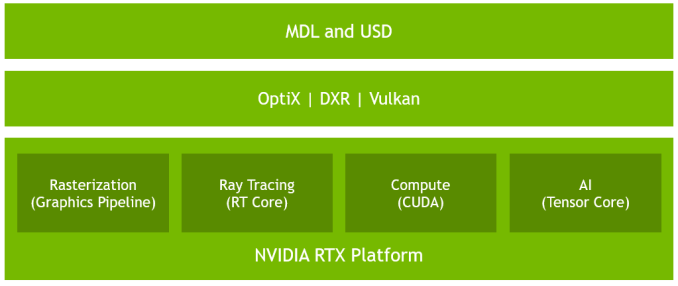The NVIDIA GeForce RTX 2080 Ti & RTX 2080 Founders Edition Review: Foundations For A Ray Traced Future
by Nate Oh on September 19, 2018 5:15 PM EST- Posted in
- GPUs
- Raytrace
- GeForce
- NVIDIA
- DirectX Raytracing
- Turing
- GeForce RTX
Meet The New Future of Gaming: Different Than The Old One
Up until last month, NVIDIA had been pushing a different, more conventional future for gaming and video cards, perhaps best exemplified by their recent launch of 27-in 4K G-Sync HDR monitors, courtesy of Asus and Acer. The specifications and display represented – and still represents – the aspired capabilities of PC gaming graphics: 4K resolution, 144 Hz refresh rate with G-Sync variable refresh, and high-quality HDR. The future was maxing out graphics settings on a game with high visual fidelity, enabling HDR, and rendering at 4K with triple-digit average framerate on a large screen. That target was not achievable by current performance, at least, certainly not by single-GPU cards. In the past, multi-GPU configurations were a stronger option provided that stuttering was not an issue, but recent years have seen both AMD and NVIDIA take a step back from CrossFireX and SLI, respectively.
Particularly with HDR, NVIDIA expressed a qualitative rather than quantitative enhancement in the gaming experience. Faster framerates and higher resolutions were more known quantities, easily demoed and with more intuitive benefits – though in the past there was the perception of 30fps as cinematic, and currently 1080p still remains stubbornly popular – where higher resolution means more possibility for details, higher even framerates meant smoother gameplay and video. Variable refresh rate technology soon followed, resolving the screen-tearing/V-Sync input lag dilemma, though again it took time to catch on to where it is now – nigh mandatory for a higher-end gaming monitor.
For gaming displays, HDR was substantively different than adding graphical details or allowing smoother gameplay and playback, because it meant a new dimension of ‘more possible colors’ and ‘brighter whites and darker blacks’ to gaming. Because HDR capability required support from the entire graphical chain, as well as high-quality HDR monitor and content to fully take advantage, it was harder to showcase. Added to the other aspects of high-end gaming graphics and pending the further development of VR, this was the future on the horizon for GPUs.
But today NVIDIA is switching gears, going to the fundamental way computer graphics are modelled in games today. Of the more realistic rendering processes, light can be emulated as rays that emit from their respective sources, but computing even a subset of the number of rays and their interactions (reflection, refraction, etc.) in a bounded space is so intensive that real time rendering was impossible. But to get the performance needed to render in real time, rasterization essentially boils down 3D objects as 2D representations to simplify the computations, significantly faking the behavior of light.
It’s on real time ray tracing that NVIDIA is staking its claim with GeForce RTX and Turing’s RT Cores. Covered more in-depth in our architecture article, NVIDIA’s real time ray tracing implementation takes all the shortcuts it can get, incorporating select real time ray tracing effects with significant denoising but keeping rasterization for everything else. Unfortunately, this hybrid rendering isn’t orthogonal to the previous concepts. Now, the ultimate experience would be hybrid rendered 4K with HDR support at high, steady, and variable framerates, though GPUs didn’t have enough performance to get to that point under traditional rasterization.
There’s a still a performance cost incurred with real time ray tracing effects, except right now only NVIDIA and developers have a clear idea of what it is. What we can say is that utilizing real time ray tracing effects in games may require sacrificing some or all three of high resolution, ultra high framerates, and HDR. HDR is limited by game support more than anything else. But the first two have arguably minimum performance standards when it comes to modern high-end gaming on PC – anything under 1080p is completely unpalatable, and anything under 30fps or more realistically 45 to 60fps hurts the playability. Variable refresh rate can mitigate the latter and framedrops are temporary, but low resolution is forever.
Ultimately, the real time ray tracing support needs to be implemented by developers via a supporting API like DXR – and many have been working hard on doing so – but currently there is no public timeline of application support for real time ray tracing, Tensor Core accelerated AI features, and Turing advanced shading. The list of games with support for Turing features - collectively called the RTX platform - will be available and updated on NVIDIA's site.













337 Comments
View All Comments
Vayra - Friday, September 21, 2018 - link
Why would I want a feature like DLSS when current AA methods do the job fine and we can also just run at native, higher resolution anyway and not use any AA whatsoever?And why would anyone care about vaporware like RTRT?
Lolimaster - Saturday, September 22, 2018 - link
No DLSS, NO.Blur.
Not capable of raytracing, just raytrace small parts of a frame on selected scenes on selected games...
Gastec - Thursday, September 27, 2018 - link
You must be joking right? What do we care if the price of manufacturing increased for Nvidia. We are mot supporters, we are clients. We don't have to support their pricing because WE ARE NOT SOCIOS! Let Nvidia reduce their costs by cutting the salaries of their CEOs and other wortless corporate officers. Then I will BUY their 2080Ti product, at the consumer-friendly price of €750Andrew LB - Thursday, September 20, 2018 - link
Except for the fact that the non founders edition is $999, not $1200. And the GTX 1080ti released at $699 but for the better part of the past two years cost substantially more.eva02langley - Thursday, September 20, 2018 - link
Then find one at that price, genius.3rd parties are OC their cards and offering additional cooling solutions, they will all be over the MSRP and close to the FE.
Also, they use GDDR6... you didn't learn anything from Vega and HBM2?
jeffcd57 - Thursday, September 20, 2018 - link
Agree the cost is ridiculous. I haven't paid it and won't. Got to many children to raise. I've never seen them at the above mentioned.jeffcd57 - Thursday, September 20, 2018 - link
1080 Ti for $600, where, when?ezridah - Thursday, September 20, 2018 - link
A month ago.https://www.theverge.com/good-deals/2018/8/21/1776...
TheJian - Thursday, September 20, 2018 - link
So buy a 1080ti. For some the new features are worthy and boost perf quite massively making it truly worth it if those technologies are the new way forward. At worst, a good 25 games are already coming with NV's new tech. Many are huge titles most would like to play surely.Also as Hexus noted a while back, the price to make these things is just below MSRP. Note the small chip is as large as a titan, and the larger chips...WOW. That's a lot of transistors for a game card. Also apples vs. oranges here, as said by others 1080 etc can't do raytracing or dlss.
https://nvidianews.nvidia.com/news/nvidia-rtx-plat...
27 games coming with NV tech. Will they look the same on 1080ti or less? NOPE. Will they be faster and BETTER looking on RTX...YEP. Value is in the eye of the beholder ;)
Spunjji - Friday, September 21, 2018 - link
The problem is, you just counted twice when you said "will they be faster and better looking on RTX".The absolute truth of it from what little we can glean so far (after the official launch!!!) is that you can have RTX effects /OR/ you can have your better performance, not both. That's a heavy caveat!
It would be one thing if it were a proposition of waiting a couple of months for some amazing features that will knock your socks off and have few drawbacks. It's another to be paying over the odds for a card now to maybe get some cool stuff that will DEFINITELY run slower and at a lower res than you're used to.